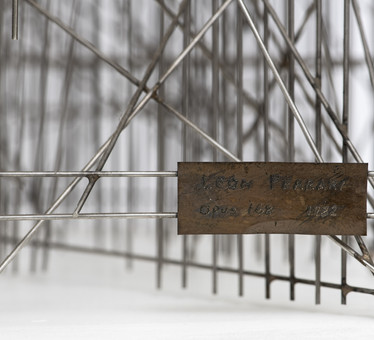León Ferrari

Buenos Aires, Argentina, 1920 —
Buenos Aires, Argentina, 2013
If iconoclasm is the act of imposing suspicions on the way a culture represents itself and its values, then León Ferrari is an iconoclast like few others. Vast and heterogeneous, his work, when embarking on an exercise in revising form and image, reveals itself as the bearer of a unique power, capable of destabilizing the authoritarian oppression of the government of men and souls.
Self-taught, Ferrari began his artistic career in the 1950s, when he worked with cement and ceramics, creating abstract and generic forms that paradoxically involve a representation of reality, such as the Mujer ceramics (1960). But it is from the 1960s that experiments with materials and text appear in his work, which, together with a vigorous criticism of Western politics and culture, make the artist’s work characteristic. Thus, Ferrari uses metal rods to form wefts that intertwine in the air and combine with names related to the historical and cultural context, such as Gagarín (1961), in which the circular shape pronounces the orbit of a rocket around the Earth. In addition to their participation in the titles, the texts also become the theme of the works themselves, explored in their meaning and visuality. In this way, the Letter to a general (1963) encodes its textual content with the drawings traced on the words, which generates an ambiguous game between the need to say and the impossibility of expression, whereas in El arca de Noé (1964) , the artist compresses the text around the cutout of a photo of Michelangelo’s David, proposing a new narrative of the flood in which women gain centrality and strength.
In 1976, after the military coup in Argentina, Ferrari took refuge in Brazil. From this period of his exile there are notable works such as the sculpture Berimbau (1978), in which the participation of the public is required for the sounds to be activated; but also the series Heliografias, drawings made by way of architectural plans that figure the ordering and disciplining of modern spaces and life, ending up showing its absurd ordering, as exemplified by Cidade (1980).
Ferrari also used in his work the oriental erotic imagery, the use of condoms, the Braille scriptures and another profuse range of materials and artifices, all integrated in an endless plastic investigation always conducted by the critical virtue, that insistent posture of unveiling what it is not only arbitrary, but also unacceptable.
VRP